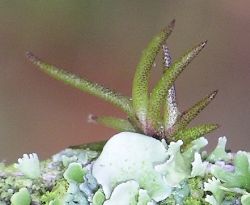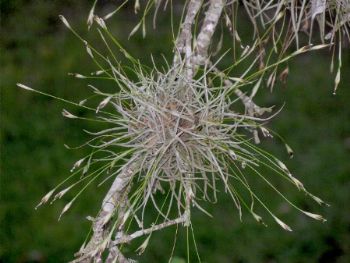Ball Moss
by Valerie (September 26, 2004)
|
There is only predominant epiphyte that lives in our area and it is ball moss (Tillandsia recurvata). Compared to the more showy species of air plants in the genus Tillandsia, ball moss leaves much to be desired. It has a profusion of fleshy but slender round leaves, which stick out in all directions, giving it the spiky ball look. It is hard to tell whether the large balls are one plant that has divided or are made up of several plants growing together.
There is a lot of controversy over whether or not ball moss kills trees. After watching how it grows in our yard and observing it in this area, it seems to rarely harm trees, but more often is noticeable on dying trees that have lost much of the newer growth in their crowns. The only damage that ball moss appears to do is to sometimes help add to the weight of large horizontal tree limbs, which then break off during heavy rains. It has been said that bad infestations of ball moss cause the tree to decline because of lack of light getting to the leaves, but ball moss does not thrive in full sun and prefers to grow in the inner part of the crown, where the leaves are usually dead anyway. Our live oaks contain a lot of ball moss on the lower and older branches, but there is almost none on the highest parts of the trees where the majority of leaves are located. Branches lower in the crown die anyway, whether or not there are ball moss plants on them. Ball moss does sometimes hinder smaller trees growing in the shade of big trees. I've seen small Texas mountain laurels growing under live oaks that are practically covered with small ball moss plants. These trees are already at a disadvantage because of the heavy shade they must endure, but the ball moss creates an additional burden. While a number of trees can host ball moss, the ideal situation seems to occur in live oaks, with slow growing and shaded inner limbs that have rough bark where the plants can find a hold.
Ball moss spreads mostly by seed. After a good rain, the plants often bloom with tiny and rather insignificant flowers, which appear on longer stalks (called peduncles) out beyond the ball of leaves. Later, a seed pod forms and then splits open to release the white fuzzy seeds. They look like large grass seed, but have hairs on them. When wet, the hairs stick to things, especially to branches. I've noticed the seeds sticking to lichen covered branches that fall in our yard. I suspect that the only real competitors that the ball moss faces for prime real estate are lichens, which grow in a dazzling array of species on many of our trees. Because the air plants in our yard are not much of a problem, we consider them to be just one more interesting species in our flora. Our dog adores playing with full grown ball moss plants (they get to be about 6 inches across) that fall to the ground when the tiny twigs on which they are growing finally break off. She usually ends up tearing them apart. After storms, there are sometimes quite a number of branches and their accompanying epiphytes strewn about our yard. The ball moss composts very well when added to our bins. Some people think that ball moss is rather ugly and, indeed, it does not usually add to the beauty of any tree. There are ways to control it, mostly with chemicals, baking soda, or pruning the branches. I can only suspect that if ball moss were as attractive as numerous other Tillandsia species prevalent along the Gulf coast, people would welcome them rather than find them a nuisance. |
 Closely related to Spanish moss and several other air plants that produce larger and prettier flowers, ball moss is more tolerant of our cold winters and hot, dry summers, thriving here with no competition from other members of the genus. Not a moss at all (mosses are not flowering plants), ball moss is a called an air plant or epiphyte because it derives all its nutrients from the air, rain, and dust, while taking nothing directly from the tree on which it is living. Just like many orchids, bromeliads, ferns, and lichens, ball moss simply needs a place to live and it usually does well in trees. It can, however, live on fences, wires, or shrubs.
Closely related to Spanish moss and several other air plants that produce larger and prettier flowers, ball moss is more tolerant of our cold winters and hot, dry summers, thriving here with no competition from other members of the genus. Not a moss at all (mosses are not flowering plants), ball moss is a called an air plant or epiphyte because it derives all its nutrients from the air, rain, and dust, while taking nothing directly from the tree on which it is living. Just like many orchids, bromeliads, ferns, and lichens, ball moss simply needs a place to live and it usually does well in trees. It can, however, live on fences, wires, or shrubs.
